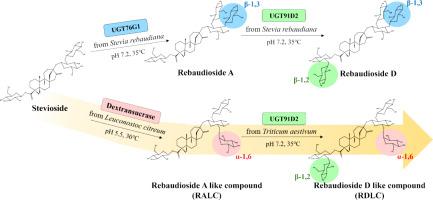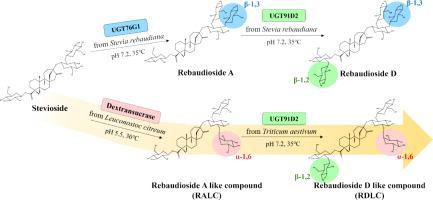葡萄糖基转移酶联合利鲍迪苷d样化合物的生物转化及特性研究
IF 9.8
1区 农林科学
Q1 CHEMISTRY, APPLIED
引用次数: 0
摘要
雷鲍迪苷D (RD)是一种替代甜味剂,由于其苦味较甜菊糖苷(ST)和雷鲍迪苷A (RA)低而受到人们的关注。但其较低的水溶性限制了其在食品工业中的应用。雷鲍迪苷d样化合物(RDLC)是由两种糖基转移酶结合合成的。首先制备雷鲍迪苷a样化合物(RALC),然后制备雷鲍迪苷a样化合物(RDLC)。分离得到的RALC和RDLC的结构通过质谱和核磁共振实验进行了表征。与RD相比,RDLC的水溶性提高了40倍,并在25 °C下保持了30 天的储存稳定性。RDLC在120 °C和pH 2 ~ 10范围内稳定。在软饮料中,与ST和RA相比,RDLC增强了稳定性。此外,与酶修饰的甜菊糖相比,RDLC的葡萄糖生成速率降低了3.52倍以上,最终转化为雷鲍迪苷E。本文章由计算机程序翻译,如有差异,请以英文原文为准。


Bioconversion and characteristics of the rebaudioside D-like compound by glucosyltransferases combination
Rebaudioside D (RD) is an alternative sweetener that has attracted attention due to its lower bitterness compared to stevioside (ST) and rebaudioside A (RA). However, its lower water solubility restricts its application in the food industry. Rebaudioside D-like compound (RDLC) was produced by combining two types of glucosyltransferases. The rebaudioside A-like compound (RALC) was produced first, followed by the production of RDLC. The structures of the isolated RALC and RDLC were elucidated by MS and NMR experiments. RDLC showed a 40-fold increase in water solubility compared to RD and maintained storage stability for 30 days at 25 °C. RDLC was stable at 120 °C and within a pH range of 2 to 10. In a soft drink, RDLC enhanced stability compared to ST and RA. Furthermore, RDLC revealed a more than 3.52-fold decrease in the glucose generation rate compared to enzymatically modified stevia, and it was finally converted to rebaudioside E.
求助全文
通过发布文献求助,成功后即可免费获取论文全文。
去求助
来源期刊

Food Chemistry
工程技术-食品科技
CiteScore
16.30
自引率
10.20%
发文量
3130
审稿时长
122 days
期刊介绍:
Food Chemistry publishes original research papers dealing with the advancement of the chemistry and biochemistry of foods or the analytical methods/ approach used. All papers should focus on the novelty of the research carried out.
 求助内容:
求助内容: 应助结果提醒方式:
应助结果提醒方式:


